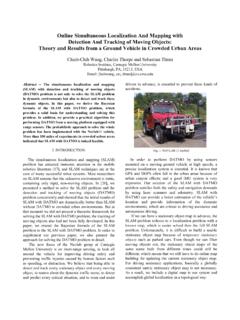Transcription of A Tutorial on Graph-Based SLAM - uni-freiburg.de
1 1A Tutorial on Graph-Based SLAMG iorgio GrisettiRainer K ummerleCyrill StachnissWolfram BurgardDepartment of Computer Science, University of Freiburg, 79110 Freiburg, GermanyAbstract Being able to build a map of the environment andto simultaneously localize within this map is an essential skill formobile robots navigating in unknown environments in absenceof external referencing systems such as GPS. This so-calledsimultaneous localization and mapping ( slam ) problem hasbeen one of the most popular research topics in mobile roboticsfor the last two decades and efficient approaches for solving thistask have been proposed.
2 One intuitive way of formulating SLAMis to use a graph whose nodes correspond to the poses of the robotat different points in time and whose edges represent constraintsbetween the poses. The latter are obtained from observationsof the environment or from movement actions carried out bythe robot. Once such a graph is constructed, the map can becomputed by finding the spatial configuration of the nodes thatis mostly consistent with the measurements modeled by theedges. In this paper, we provide an introductory descriptionto the Graph-Based slam problem.
3 Furthermore, we discussa state-of-the-art solution that is based on least-squares errorminimization and exploits the structure of the slam problemsduring optimization. The goal of this Tutorial is to enable thereader to implement the proposed methods from INTRODUCTIONTo efficiently solve many tasks envisioned to be carried outby mobile robots including transportation, search and rescue,or automated vacuum cleaning robots need a map of theenvironment. The availability of an accurate map allows forthedesign of systems that can operate in complex environmentsonly based on their on-board sensors and without relyingon external reference system like, , GPS.
4 The acquisitionof maps of indoor environments, where typically no GPS isavailable, has been a major research focus in the roboticscommunity over the last decades. Learning maps under poseuncertainty is often referred to as the simultaneous localizationand mapping ( slam ) problem. In the literature, a large varietyof solutions to this problem is available. These approachescan be classified either as filtering or smoothing. Filteringapproaches model the problem as an on-line state estimationwhere the state of the system consists in thecurrentrobot po-sition and the map.
5 The estimate is augmented and refined byincorporating the new measurements as they become techniques like Kalman and information filters [28],[3], particle filters [22], [12], [9], or information filters[7],[31] fall into this category. To highlight their incrementalnature, the filtering approaches are usually referred to ason-line slam methods. Conversely, smoothing approachesestimate the full trajectory of the robot from the full set ofmeasurements [21], [5], [27]. These approaches address theso-called full slam problem, and they typically rely on least-square error minimization 1 shows three examples of real robotic systemsthat use slam technology: an autonomous car, a tour-guiderobot, and an industrial mobile manipulation robot.
6 Image(a) shows the autonomous car Junior as well as a modelof a parking garage that has been mapped with that to the acquired model, the car is able to park itselfautonomously at user selected locations in the garage. Image(b) shows the TPR-Robina robot developed by Toyota whichis also used in the context of guided tours in museums. Thisrobot uses slam technology to update its map whenever theenvironment has been changed. Robot manufacturers such asKUKA, recently presented mobile manipulators as shown inImage (c). Here, slam technology is needed to operate suchdevices in flexible way in changing industrial 2 illustrates 2D and 3D maps that can be estimated bythe slam algorithm discussed in this intuitive way to address the slam problem is viaits so-called Graph-Based formulation.
7 Solving a graph -basedSLAM problem involves to construct a graph whose nodesrepresent robot poses or landmarks and in which an edgebetween two nodes encodes a sensor measurement that con-strains the connected poses. Obviously, such constraints can becontradictory since observations are always affected by such a graph is constructed, the crucial problem is tofind a configuration of the nodes that is maximally consistentwith the measurements. This involves solving a large errorminimization Graph-Based formulation of the slam problem hasbeen proposed by Lu and Milios in 1997 [21].
8 However, ittook several years to make this formulation popular due to thecomparably high complexity of solving the error minimizationproblem using standard techniques. Recent insights into thestructure of the slam problem and advancements in the fieldsof sparse linear algebra resulted in efficient approaches tothe optimization problem at hand. Consequently, graph -basedSLAM methods have undergone a renaissance and currentlybelong to the state-of-the-art techniques with respect to speedand accuracy. The aim of this Tutorial is to introduce the slam problem in its probabilistic form and to guide the reader tothe synthesis of an effective and state-of-the-art graph -basedSLAM method.
9 To understand this Tutorial a good knowledgeof linear algebra, multivariate minimization, and probabilitytheory are PROBABILISTICFORMULATION OFSLAMS olving the slam problem consists of estimating the robottrajectory and the map of the environment as the robot movesin it. Due to the inherent noise in the sensor measurements, aSLAM problem is usually described by means of probabilistictools. The robot is assumed to move in an unknown environ-ment, along a trajectory described by the sequence of random2(a)(b)(c)Fig. of slam technology. (a) An autonomous instrumented car developed at Stanford.
10 This car can acquire maps by utilizing only itson-board sensors. These maps can be subsequently used for autonomous navigation. (b) The museum guide robot TPR-Robina developed by Toyota (picturecourtesy of Toyota Motor Company). This robot acquires a new map every time the museum is reconfigured. (c) The KUKA Concept robot Omnirob , amobile manipulator designed autonomously navigate and operate in the environment with the sole use of its on-board sensors (picture courtesy of KUKAR oboter GmbH).variablesx1:T={x1, .. ,xT}. While moving, it acquires asequence of odometry measurementsu1:T={u1.}










